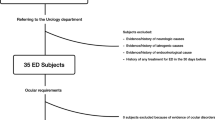Abstract
Penile NO release test (PNORT) has been designed to try to evaluate clinically the penile endothelial function (PEF). The shear-stress flow-mediated vasodilation (FMD) of the cavernous arteries is evaluated in two groups of patients with neurogenic (n=23) and vasculogenic (n=23) erectile dysfunction (ED) by measuring their percent of increase after a 5 min occlusion of the flow. Both groups show an important FMD decrease (17.78±11.78 and 17.82±13%) as compared to the age-matched control group (n=12) (65.14±30.5%, P<0.001). In the vasculogenic and control groups, mean FMD is lower in patients with one or more arterial risk factors(41 vs 67%, P=0.025), and show a positive correlation with the plasmatic levels of bioavailable testosterone (r=0.37, P=0.03) and of DHEA-S (r=0.46, P=0.014). Patients achieving full erection at pharmacological test with visual sexual stimulation have a higher FMD (43.8±38%) than those who did not (18.52±14.37%, P=0.008). We confirm clinically that PEF is strongly impaired in organic ED linked to neurological, vascular and endocrine factors.
This is a preview of subscription content, access via your institution
Access options
Subscribe to this journal
Receive 8 print issues and online access
$259.00 per year
only $32.38 per issue
Buy this article
- Purchase on Springer Link
- Instant access to full article PDF
Prices may be subject to local taxes which are calculated during checkout

Similar content being viewed by others
References
Burnett AL, Lowenstein CJ, Bredt DS, Chang TSK . Snyder SH nitric oxide; a physiologic mediator of penile erection. Science 1992; 257: 401–403.
Hurt KJ et al. Akt-dependent phosphorylation of endothelial nitric-oxide synthase mediate penile erection. Proc Natl Acad Sci USA 2002; 5: 189–197.
Joannides R et al. Nitric oxide is responsible for flow-dependent dilatation of human peripheral conduit arteries in vivo. Circulation 1995; 91: 1314–1319.
Meredith IT et al. Post ischemic vasodilatation in human forearm is dependent of endothelium derived nitric oxide. Am J Physiol 1996; 270: 435–440.
Vogel RA . Measurement of endothelial function by brachial artery flow mediated vasodilation. Am J Cardiol 2001; 88 (2-A): 31E–34E.
Virag R . Vasodilatation post occlusive des artères caverneuses. Un test potentiel de la réserve en NO du pénis. J Mal Vasc 2002; 27: 214–217.
Virag R, Beck-Ardilly L, Floresco J . Modélisation clinique et algorythme décisionnel dans la prise en charge des troubles de l'érection. Rev Med Int 1997; 18 (Supp 1): 26s–31s.
Ballesthoffer BM et al. Influence of experience on intra and interindividual variability in assessing peripheral endothelial dysfunction with high resolution ultrasound. Ultraschall Med 2001; 5: 231–235.
Aversa et al. Androgen and penile erection; an evidence for a direct relation between free testosterone and cavernous vasodilation in men erectile dysfunction. Clin Endocrinol 2000; 53: 517–522.
Dietz NM et al. Nitric oxide contributes to the rise in forearm blood flow during mental stress in humans. J Physiol 1994; 481: 361–368.
Author information
Authors and Affiliations
Corresponding author
Rights and permissions
About this article
Cite this article
Virag, R., Floresco, J. & Richard, C. Impairment of shear-stress-mediated vasodilation of cavernous arteries in erectile dysfunction. Int J Impot Res 16, 39–42 (2004). https://doi.org/10.1038/sj.ijir.3901122
Received:
Revised:
Accepted:
Published:
Issue Date:
DOI: https://doi.org/10.1038/sj.ijir.3901122
Keywords
This article is cited by
-
Physiological regulation of penile arteries and veins
International Journal of Impotence Research (2008)
-
Relationship between chronic tadalafil administration and improvement of endothelial function in men with erectile dysfunction: a pilot study
International Journal of Impotence Research (2007)
-
The effect of vardenafil on endothelial function of brachial and cavernous arteries
International Journal of Impotence Research (2006)



